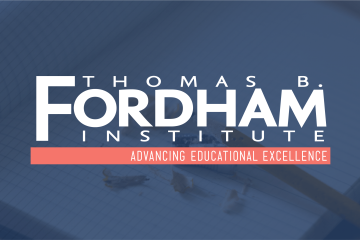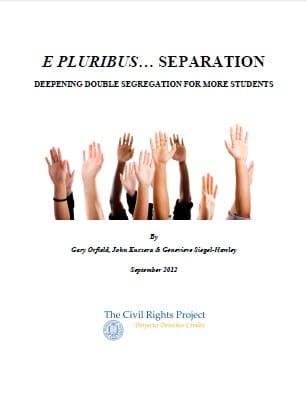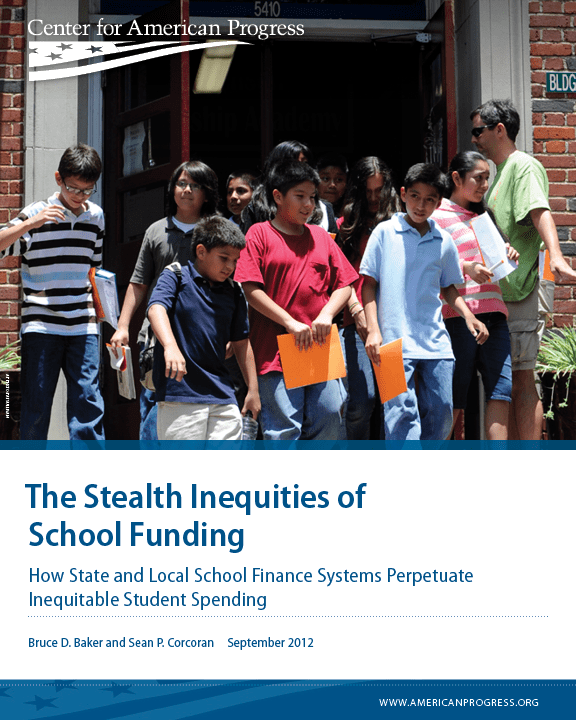
Won't Back Down
Grab the popcorn...and a tissue











 In January 2010, California became the first state to offer parents another path when it passed the Parent Empowerment Act, aka “parent trigger” law. This measure allows parents to force turnaround efforts at a school, similar to those framed by the federal School Improvement Grant program, including reconstitution as a charter and replacement of half the staff. Since then, six other states have adopted “trigger” legislation (including Ohio, which passed a pilot program for Columbus City Schools in 2011). Another twenty-plus have considered (or are currently considering) similar legislation. This form of parent empowerment has merit, even if it hasn’t actually happened yet in real places. Indeed, no real school has successfully implemented a parent trigger—for school systems, teacher groups, and other establishment forces have myriad means available to block it.
In January 2010, California became the first state to offer parents another path when it passed the Parent Empowerment Act, aka “parent trigger” law. This measure allows parents to force turnaround efforts at a school, similar to those framed by the federal School Improvement Grant program, including reconstitution as a charter and replacement of half the staff. Since then, six other states have adopted “trigger” legislation (including Ohio, which passed a pilot program for Columbus City Schools in 2011). Another twenty-plus have considered (or are currently considering) similar legislation. This form of parent empowerment has merit, even if it hasn’t actually happened yet in real places. Indeed, no real school has successfully implemented a parent trigger—for school systems, teacher groups, and other establishment forces have myriad means available to block it.
For a preview of how it might really happen, we turn to Hollywood: This film—produced (and presumably subsidized) by Philip Anschutz’s Walden Media and starring Viola Davis (The Help, Doubt) and Maggie Gyllenhaal (Crazy Heart)—chronicles the efforts of two moms (one of them also a teacher) as they struggle to reconstitute their horrific Pittsburgh elementary school under the state's hypothetical "Fail Safe Act." (No, Pennsylvania hasn’t passed a parent-trigger law yet.)
All the essential—and predictable—characters are featured: The apathetic and/or change-averse school-board members; the conniving teacher-union head; the vindictive and heinous principal; the dedicated teachers—and also those more worried about pension accrual (or job retention) than student achievement. Maybe it’s a little formulaic. But maybe it needs to be if viewers are successfully to imagine something that hasn’t yet happened in the real world.
To the filmmakers’ credit, the politics and charged emotions on display within and among these groups feel plenty real. While parent-trigger legislation is the muse of Won’t Back Down, issues of choice, unions, governance, curricular design, instructional effectiveness, and school (and individual) accountability are also present. A couple of kids have disabilities. Parents don’t have much money—and are at their wits’ ends to get their children a decent education in a gritty neighborhood. Your eyes may well moisten as you watch.
Showcasing such issues in a general-distribution movie (coming tomorrow to a theater near you) is apt to widen the fan base for parent-trigger legislation and perhaps other needed reforms. That’s undeniably a good thing to do. The question then becomes: How do we keep fiction from permanently being truer than reality?
SOURCE: Daniel Barz, Won’t Back Down (Walden Media, September 28, 2012).

 Gary Orfield’s Civil Rights Project routinely presents—and laments—stark numbers on segregation (both racial and socioeconomic) in U.S. classrooms; this latest report is no different. It shows that racial segregation is on the rise, even in the face of the shifting demographics of America’s schools (white students’ “market share” of public school enrollment dropped 25 percent over the past thirty years): Fifteen percent of black students and 14 percent of Latino students attend schools that are less than 1 percent white (and 74 and 80 percent, respectively, attend majority non-white schools). Further, while the typical white student attends a school that is about one-third low income; the typical black student’s school is about two-thirds low income. But what is the role of schools and school systems in arresting or reversing such trends, which have so much to do with housing policy, income, neighborhood demographics, ethnic preferences, and parental choice? Orfield has his own answers, of course: paternalistic policy recommendations that include expanding magnet schools, reversing Supreme Court decisions, and constructing civil-rights policies for charter schools. But forcibly creating diverse schools is as logistically taxing as it is politically unpalatable. Instead of top-down mandates, Orfield and co. might better consider a “controlled choice” approach to diverse schools—treating them as one component of a larger school-choice movement that allows parents to choose a high-performing charter or district-run STEM school, just as much as a diverse classroom.
Gary Orfield’s Civil Rights Project routinely presents—and laments—stark numbers on segregation (both racial and socioeconomic) in U.S. classrooms; this latest report is no different. It shows that racial segregation is on the rise, even in the face of the shifting demographics of America’s schools (white students’ “market share” of public school enrollment dropped 25 percent over the past thirty years): Fifteen percent of black students and 14 percent of Latino students attend schools that are less than 1 percent white (and 74 and 80 percent, respectively, attend majority non-white schools). Further, while the typical white student attends a school that is about one-third low income; the typical black student’s school is about two-thirds low income. But what is the role of schools and school systems in arresting or reversing such trends, which have so much to do with housing policy, income, neighborhood demographics, ethnic preferences, and parental choice? Orfield has his own answers, of course: paternalistic policy recommendations that include expanding magnet schools, reversing Supreme Court decisions, and constructing civil-rights policies for charter schools. But forcibly creating diverse schools is as logistically taxing as it is politically unpalatable. Instead of top-down mandates, Orfield and co. might better consider a “controlled choice” approach to diverse schools—treating them as one component of a larger school-choice movement that allows parents to choose a high-performing charter or district-run STEM school, just as much as a diverse classroom.
SOURCE: Gary Orfield, John Kucsera, and Genevieve Siegel-Hawley, E Pluribus...Separation: Deepening Double Segregation for More Students (Los Angeles, CA: The Civil Rights Project, September 2012).

 This Center for American Progress report spotlights “often-overlooked features of school funding systems” that aggravate inequities in per-pupil spending, leaving students in wealthier districts with more edu-dollars than those in needier locales. In Part I of the report, Rutgers professor Bruce Baker offers a succinct primer on state aid formulas, and then details how the formulas of six states (Illinois, Missouri, North Carolina, New York, Pennsylvania, and Texas) have created especially "regressive" funding patterns. (In New York, for example, 0 percent poverty districts receive about $2,000 more per pupil than those with a 30 percent poverty rate.) In Part II, NYU’s Sean Corcoran highlights how local-revenue structures—mainly property taxes—worsen such inequities. (Federal Title I dollars, the authors argue, do little to offset the progressive or regressive nature of states’ school-finance systems.) The report helpfully unpacks an important and complicated issue, but its recommendations for change are disappointing. Baker and Corcoran acknowledge that ensuring funding equity must be done at the state level, but they offer few concrete steps for their case-study states to reach this aim. States searching for such a step would be wise to read up on weighted-student funding.
This Center for American Progress report spotlights “often-overlooked features of school funding systems” that aggravate inequities in per-pupil spending, leaving students in wealthier districts with more edu-dollars than those in needier locales. In Part I of the report, Rutgers professor Bruce Baker offers a succinct primer on state aid formulas, and then details how the formulas of six states (Illinois, Missouri, North Carolina, New York, Pennsylvania, and Texas) have created especially "regressive" funding patterns. (In New York, for example, 0 percent poverty districts receive about $2,000 more per pupil than those with a 30 percent poverty rate.) In Part II, NYU’s Sean Corcoran highlights how local-revenue structures—mainly property taxes—worsen such inequities. (Federal Title I dollars, the authors argue, do little to offset the progressive or regressive nature of states’ school-finance systems.) The report helpfully unpacks an important and complicated issue, but its recommendations for change are disappointing. Baker and Corcoran acknowledge that ensuring funding equity must be done at the state level, but they offer few concrete steps for their case-study states to reach this aim. States searching for such a step would be wise to read up on weighted-student funding.
SOURCE: Bruce D. Baker and Sean P. Corcoran, The Stealth Inequities of School Funding: How State and Local Finance Systems Perpetuate Inequitable Student Spending (Washington, D.C.: Center for American Progress, September 2012).

Mike and Rick wonder if there’s still room for ed reformers in the Democratic Party after Chicago. Amber analyzes why American students continue to struggle with the SAT. And Rick makes a few jokes at Karen Lewis’s expense.
The SAT Report on College & Career Readiness: 2012 - The College Board Download PDF

Is digital learning education's latest fad or its future? What fundamental changes to the ways we fund, staff, and govern American schools are necessary to fulfill the technology's potential? Will policy tweaks suffice or do we need a total system overhaul—and a big change in the reform priorities that can bring this about? Who will resist—and do their objections have merit? Fordham is bringing together experts on all aspects of education policy—from governance to finance to human capital—to examine how policymakers can make digital learning a transformative tool to improve American education...and weigh the dangers that lie ahead.
The panel featured the governance expertise of the Hoover Institution's John Chubb, insights into teaching's future from Bryan Hassel of Public Impact, analysis of the costs of online learning from the Parthenon Group's Eleanor Laurans, and the cautionary perspective of Emory University's Mark Bauerlein.

 You can explain away yet another (slight) decline in SAT scores by citing the expanding test-taking population and its changing demographics. But let’s face it: The longest-lived and most widely noted marker of American high school attainment continues to flat-line, or worse, despite all the reforming, all the spending, and all the hand-wringing.
You can explain away yet another (slight) decline in SAT scores by citing the expanding test-taking population and its changing demographics. But let’s face it: The longest-lived and most widely noted marker of American high school attainment continues to flat-line, or worse, despite all the reforming, all the spending, and all the hand-wringing.
The American Enterprise Institute’s resident education gurus, Rick Hess and Andrew Kelly, offer up a clear-headed plan for a conservative federal education agenda in the latest edition of National Affairs. While there are historical oversimplifications (particularly their take on the Reagan and Bush I eras), and there’s far too little attention to the complexities of civil-rights enforcement (and the federal role therein), the essay provides a valuable look at the contradictions of conservatives in the education arena and defines a clear and useful role for the national government that leaders in Washington (and candidates hoping to join those ranks) would be wise to give more than a glance.
Randi Weingarten and Karen Lewis teamed up to defend the teacher union's victory in the recent Chicago strike (and bury any hint of a power struggle?) in the pages of the Wall Street Journal this week. "Solution-driven unionism" is unlikely to win many converts among the Journal's readers but it was a welcome reminder that, while they may have prevailed on the streets of Chicago, the teacher unions still have plenty they need to defend to the nation regarding their actions over the last few weeks.
Forget New Orleans and New York City. Ground zero for education reform these days is (!) Boise. Armed with a talented state chief in Tom Luna and a hard-charging governor in Butch Otter, Idaho is positioned to enact major changes to teacher policy this fall. While squabbles over class size between the presidential candidates may steal the national headlines, it’s state-level moves like this that matter most for schools and kids.

It’s well established that the Common Core State Standards (CCSS)—adopted in principle by forty-six states—won’t get any real traction unless they’re comprehensively and faithfully implemented at the state and local levels. (They also have implications for federal policy and programs, of course.)
 What we've heard about the Common Core's impact is just the tip of the iceberg . Photo by Natalie Lucier. |
But what is comprehensive implementation? True, we’ve heard much palaver about what the Common Core portends for assessment, for teachers’ professional development, and for curricular/instructional materials. All true, all crucial, and all probably the most urgent. But these issues are also just the tip of the CCSS iceberg, most of which remains invisible under water. What I haven’t seen yet is clear recognition that the Common Core, taken seriously, eventually changes everything in American education and that implementation, done right, must be comprehensive.
Which means what? Start with a substantial analogy: World War II. A new book profiles General Albert C. Wedemeyer, who was assigned by General Marshall to the Army’s “War Plans Department” as the conflict loomed and (I quote the Wall Street Journal’s book review) “tasked…with reducing America’s mobilization requirements to a single document.” Then FDR asked Wedemeyer’s team to turn it “into a blueprint on how to defeat America’s likely enemies in a future war.” The book explains:
The Wedemeyer plan was carried out only in part. (Churchill was convinced that an early invasion of the European continent would end disastrously.) But, dramatic though this may seem, full-on Common Core implementation will demand a plan a plan of similar comprehensiveness and vision. I don’t know who will play the role of Albert Wedemeyer, but maybe we can accelerate the process by offering a provisional table of contents.
Here’s my list of topics that the plan should include, submitted with some humility, as I’ve surely overlooked important items (bring ‘em on!), and with some trepidation, as understanding these implications may cause Common Core skeptics to stiffen their resistance.
The Common Core sets forth what students needs to have learned by the end of each year. It doesn’t help teachers with “scope and sequence,” much less lesson planning. Not all teachers want such help—and there’s much shrieking about “national curriculum”—but some will welcome guidance. (Keep it voluntary!)
Every big ELA- and math-textbook publisher has already declared that its products are “aligned” with the Common Core, but mostly that’s not true. Who is going to apply the excellent publishers’ guidelines produced by Student Achievement Partners and actually rate the textbooks (and fast-proliferating digital resources) on how well they’re aligned?
Traditional U.S. textbooks and “reading programs”—bulky, lumbering, and linear—aren’t going to work very well with the instructional demands of the Common Core. Teachers will need to be able to muster instructional resources from many sources, including electronic ones. (Some excellent nonprofit groups are already at work on materials that will end up being freely available, which also portends a radical transformation of the textbook market!)
How do we keep K-12 education from being whittled down to the two subjects in the Common Core? Yes, “next generation” science standards are in the works. But what about history, geography, civics, languages, and the arts? Health and phys ed? Where do they fit? What standards will apply? How will they be taught and assessed?
Hundreds of thousands of current teachers need to update, alter, and amplify their own knowledge base and pedagogical arsenal if they’re to succeed in imparting the Common Core to their pupils.
Pretty nearly every teacher-preparation program in the land, whether university-based or “alternative,” will need to revamp its own standards and curriculum if it’s to prepare tomorrow’s instructors to impart the Common Core to their students. Ditto for those who purport to train school leaders. A lot of professors will need to change their ways, too!
These will change, too, with implications for everything that is attached to them (tenure decisions, merit pay, layoffs, and more). Will it get harder or easier to make “value-added” calculations at the classroom level once Common Core assessments kick in? What about rubrics for teacher observations? (And how well trained will those observers be in what to look for in a Common Core classroom?)
I wager that today’s standard school day and year will prove insufficient for many kids to master the Common Core plus everything else that they need to learn. Can instructional time be individualized, too, in school or online? What are the budget implications?
Some states have third-grade “reading guarantees,” but what about the rest of the K-12 sequence? Will going from sixth grade to seventh hinge on a student having mastered the Common Core standards for sixth? What about entering high school? Earning a diploma? Will this continue to be based on Carnegie units and course credits or on actual mastery? (And what about subjects outside ELA and math?) What does Common Core portend for the two dozen or so states with high-school-graduation tests that are pegged to yesterday’s ninth- or tenth-grade expectations?
Though the Common Core is built around grade levels, kids don’t learn at the same speed—and individualization of instruction grows ever more important. What about moving kids forward as they master stuff rather than through lock-step progressions? Why can’t one be in third grade for ELA, say, and fourth or fifth for math? How about those who will need five years rather than four to master the challenges of high school? (Today they’re counted as “drop outs” in most states’ statistics!) And since we can no longer afford to individualize by shrinking class size further, we’ll need to rely more on technology—which the new assessments also need—and on more flexible ways of organizing school itself.
Remind yourself what the Common Core expects Kindergartners to learn (review page ten of the ELA standards or page eleven of math standards). Then ask yourself what must a child know and be able to do upon entry into Kindergarten to maximize the odds that she will be ready to succeed there. Then ponder how few of today’s preschool programs (Head Start included) have standards, curricula, and staff that are up to this challenge? And how many of today’s needy pre-Kindergartners don’t even have access to those programs?
This stuff is evolving at warp speed, with profound implications for schooling and for kids’ lives. Much of it’s about communication and entertainment, but as those realms overlap more with formal education—for good and ill—and as more kids gain 24/7 access to all of them, what will this mean for K-12 schooling? How much of it will actually take place in school? How much will require flesh-and-blood instructors—and of what sorts? And what’s to become of libraries, book rooms, backpacks, and the rest? Picture every school kid with her own iPad in hand…
New Common Core assessments are under development for deployment in 2014-15—and let’s hope they turn out well—but for states and districts to make good use of them means rethinking their entire approach to student assessment, right down to the classroom level. How will the end of a “six-week unit,” for example, be assessed? What about those end-of-week vocabulary reviews? Weekly reports to parents on what was and wasn’t learned?
Most state accountability systems incorporate multiple factors, including but not limited to student test scores, which are geared to current state standards and tests. Every state does it differently—and those differences are apt to widen as federal NCLB prescriptions ease with recent waivers and (maybe someday) ESEA reauthorization. States that embrace the Common Core will need to reconstruct their accountability systems, as will districts that have their own.
Then there’s the GED and other ways of gauging “equivalency” for those who don’t earn a conventional on-schedule diploma. Big changes are afoot there, but will the new tests equate to the Common Core—and redress the long-standing problem of the GED: namely that people possessing it don’t fare much better in life than dropouts?
What happens, politically, when graduation rates plummet and dropout rates soar, at least for a few years? Are states and communities ready for this? Nobody ever is. But does that mean we’ll “phase in” the more rigorous graduation expectations? How long will that take?
Once Common Core rigor takes hold (if ever) of high-school-exit expectations, will our universities actually accept that diploma as proof of college readiness? Will it yield automatic admission and placement into credit-bearing college courses? If not, why should K-12 students (and parents and taxpayers) take it seriously? If it does, what happens to faculty members who have been teaching remedial courses? What happens to collegiate English and math classes if entering students are truly prepared? Will that compulsory first-year writing course still be needed?
The Common Core claims to be geared to college and career readiness. We know that not everyone is headed to (or belongs in) college, at least not the four-year kind. But what exactly are the implications for employer expectations, hiring practices, and on-the-job training? (How about the armed forces as a major employer?) How about secondary-level technical-vocational education? Will Common Core expectations make it into those institutions, too? That will likely mean major-league curricular and instructional alteration.
Everybody knows this but it needs underscoring: When Congress gets around to reauthorizing the Elementary and Secondary Education Act—and other programs such as IDEA, Head Start and TRIO—it must contend with the changed expectations that most states will have for their students and the implications of those changes for the special populations, additional services, and so forth that Uncle Sam focuses on. And it must do so without turning the Common Core itself into a federal mandate. (Remember, four states want no part of it—and at least a few more are apt to back out along the way.)
The role of the Nation’s Report Card will evolve, too. If most states end up using new English language arts and math assessments, calibrated to Common Core standards, at the individual, building, district, and state levels, there will be less cause to press for NAEP (and PISA, TIMSS, etc.) to be administered to everybody. But NAEP will remain the crucial external auditor for Common Core states and those that do their own thing. At the same time, the curricular frameworks that determine what NAEP assesses may need to be re-examined.
Yikes. It’s sort of scary. Daunting. Politically and organizationally challenging. Expensive in a time of tight budgets. Disruptive to myriad entrenched institutions and practices. But if we don’t wrap our minds around the totality of it, we may not win this war. Are you listening, General Wedemeyer?

I thought Checker Finn penned a good commentary on the recent Chicago strike, but one stylistic change is called for. Describing the unions as “selfish” rather than “pursuing their self-interests” tends to make readers think he is accusing them of collective personal flaws. They are bad people because they are…selfish, greedy, etc. The unions exist to represent the teachers and cut the best deal for them. That is solely why they exist. The union does not represent the students, parents, or taxpayers. (Despite their claims to do so.) This does not necessarily make them bad people.
Markets consist of two self-interested parties striking a deal as to price and product. The fair and legal pursuit of self-interest is at the heart of capitalism and the assumption of individual liberty over limited government in the Constitution. The real problem is that there is no counterparty to negotiate with the public-sector union. The structure is rigged because of the rules that allow unions to corrupt public officials through campaign contributions, phone banks, and union-worker armies of organizers for elections. Public officials are supposed to represent the taxpayers, the parents, and the students, but they unfortunately do not because of the political weapons the unions wield. Either those weapons have to be eliminated or the right to organize as a union for public-sector employees has to be ended. While pursuing one’s self-interest may not be a bad thing, corruption in the pursuit of it clearly is.
While the public and commentators may realize it now, those memories fade quickly. It has to be confronted more directly and substantively—like it was in Wisconsin or by threatening to outsource the work of public unions to private enterprises as can be done with private haulers for sanitation, charter schools for education, etc.
-Michael W. Kelly
President and CEO of Central Park Credit Bank; Trustee of the Thomas B. Fordham Institute

Is digital learning education's latest fad or its future? What fundamental changes to the ways we fund, staff, and govern American schools are necessary to fulfill the technology's potential? Will policy tweaks suffice or do we need a total system overhaul—and a big change in the reform priorities that can bring this about? Who will resist—and do their objections have merit? Fordham is bringing together experts on all aspects of education policy—from governance to finance to human capital—to examine how policymakers can make digital learning a transformative tool to improve American education...and weigh the dangers that lie ahead.
The panel featured the governance expertise of the Hoover Institution's John Chubb, insights into teaching's future from Bryan Hassel of Public Impact, analysis of the costs of online learning from the Parthenon Group's Eleanor Laurans, and the cautionary perspective of Emory University's Mark Bauerlein.

Is digital learning education's latest fad or its future? What fundamental changes to the ways we fund, staff, and govern American schools are necessary to fulfill the technology's potential? Will policy tweaks suffice or do we need a total system overhaul—and a big change in the reform priorities that can bring this about? Who will resist—and do their objections have merit? Fordham is bringing together experts on all aspects of education policy—from governance to finance to human capital—to examine how policymakers can make digital learning a transformative tool to improve American education...and weigh the dangers that lie ahead.
The panel featured the governance expertise of the Hoover Institution's John Chubb, insights into teaching's future from Bryan Hassel of Public Impact, analysis of the costs of online learning from the Parthenon Group's Eleanor Laurans, and the cautionary perspective of Emory University's Mark Bauerlein.

 Gary Orfield’s Civil Rights Project routinely presents—and laments—stark numbers on segregation (both racial and socioeconomic) in U.S. classrooms; this latest report is no different. It shows that racial segregation is on the rise, even in the face of the shifting demographics of America’s schools (white students’ “market share” of public school enrollment dropped 25 percent over the past thirty years): Fifteen percent of black students and 14 percent of Latino students attend schools that are less than 1 percent white (and 74 and 80 percent, respectively, attend majority non-white schools). Further, while the typical white student attends a school that is about one-third low income; the typical black student’s school is about two-thirds low income. But what is the role of schools and school systems in arresting or reversing such trends, which have so much to do with housing policy, income, neighborhood demographics, ethnic preferences, and parental choice? Orfield has his own answers, of course: paternalistic policy recommendations that include expanding magnet schools, reversing Supreme Court decisions, and constructing civil-rights policies for charter schools. But forcibly creating diverse schools is as logistically taxing as it is politically unpalatable. Instead of top-down mandates, Orfield and co. might better consider a “controlled choice” approach to diverse schools—treating them as one component of a larger school-choice movement that allows parents to choose a high-performing charter or district-run STEM school, just as much as a diverse classroom.
Gary Orfield’s Civil Rights Project routinely presents—and laments—stark numbers on segregation (both racial and socioeconomic) in U.S. classrooms; this latest report is no different. It shows that racial segregation is on the rise, even in the face of the shifting demographics of America’s schools (white students’ “market share” of public school enrollment dropped 25 percent over the past thirty years): Fifteen percent of black students and 14 percent of Latino students attend schools that are less than 1 percent white (and 74 and 80 percent, respectively, attend majority non-white schools). Further, while the typical white student attends a school that is about one-third low income; the typical black student’s school is about two-thirds low income. But what is the role of schools and school systems in arresting or reversing such trends, which have so much to do with housing policy, income, neighborhood demographics, ethnic preferences, and parental choice? Orfield has his own answers, of course: paternalistic policy recommendations that include expanding magnet schools, reversing Supreme Court decisions, and constructing civil-rights policies for charter schools. But forcibly creating diverse schools is as logistically taxing as it is politically unpalatable. Instead of top-down mandates, Orfield and co. might better consider a “controlled choice” approach to diverse schools—treating them as one component of a larger school-choice movement that allows parents to choose a high-performing charter or district-run STEM school, just as much as a diverse classroom.
SOURCE: Gary Orfield, John Kucsera, and Genevieve Siegel-Hawley, E Pluribus...Separation: Deepening Double Segregation for More Students (Los Angeles, CA: The Civil Rights Project, September 2012).

 This Center for American Progress report spotlights “often-overlooked features of school funding systems” that aggravate inequities in per-pupil spending, leaving students in wealthier districts with more edu-dollars than those in needier locales. In Part I of the report, Rutgers professor Bruce Baker offers a succinct primer on state aid formulas, and then details how the formulas of six states (Illinois, Missouri, North Carolina, New York, Pennsylvania, and Texas) have created especially "regressive" funding patterns. (In New York, for example, 0 percent poverty districts receive about $2,000 more per pupil than those with a 30 percent poverty rate.) In Part II, NYU’s Sean Corcoran highlights how local-revenue structures—mainly property taxes—worsen such inequities. (Federal Title I dollars, the authors argue, do little to offset the progressive or regressive nature of states’ school-finance systems.) The report helpfully unpacks an important and complicated issue, but its recommendations for change are disappointing. Baker and Corcoran acknowledge that ensuring funding equity must be done at the state level, but they offer few concrete steps for their case-study states to reach this aim. States searching for such a step would be wise to read up on weighted-student funding.
This Center for American Progress report spotlights “often-overlooked features of school funding systems” that aggravate inequities in per-pupil spending, leaving students in wealthier districts with more edu-dollars than those in needier locales. In Part I of the report, Rutgers professor Bruce Baker offers a succinct primer on state aid formulas, and then details how the formulas of six states (Illinois, Missouri, North Carolina, New York, Pennsylvania, and Texas) have created especially "regressive" funding patterns. (In New York, for example, 0 percent poverty districts receive about $2,000 more per pupil than those with a 30 percent poverty rate.) In Part II, NYU’s Sean Corcoran highlights how local-revenue structures—mainly property taxes—worsen such inequities. (Federal Title I dollars, the authors argue, do little to offset the progressive or regressive nature of states’ school-finance systems.) The report helpfully unpacks an important and complicated issue, but its recommendations for change are disappointing. Baker and Corcoran acknowledge that ensuring funding equity must be done at the state level, but they offer few concrete steps for their case-study states to reach this aim. States searching for such a step would be wise to read up on weighted-student funding.
SOURCE: Bruce D. Baker and Sean P. Corcoran, The Stealth Inequities of School Funding: How State and Local Finance Systems Perpetuate Inequitable Student Spending (Washington, D.C.: Center for American Progress, September 2012).

 In January 2010, California became the first state to offer parents another path when it passed the Parent Empowerment Act, aka “parent trigger” law. This measure allows parents to force turnaround efforts at a school, similar to those framed by the federal School Improvement Grant program, including reconstitution as a charter and replacement of half the staff. Since then, six other states have adopted “trigger” legislation (including Ohio, which passed a pilot program for Columbus City Schools in 2011). Another twenty-plus have considered (or are currently considering) similar legislation. This form of parent empowerment has merit, even if it hasn’t actually happened yet in real places. Indeed, no real school has successfully implemented a parent trigger—for school systems, teacher groups, and other establishment forces have myriad means available to block it.
In January 2010, California became the first state to offer parents another path when it passed the Parent Empowerment Act, aka “parent trigger” law. This measure allows parents to force turnaround efforts at a school, similar to those framed by the federal School Improvement Grant program, including reconstitution as a charter and replacement of half the staff. Since then, six other states have adopted “trigger” legislation (including Ohio, which passed a pilot program for Columbus City Schools in 2011). Another twenty-plus have considered (or are currently considering) similar legislation. This form of parent empowerment has merit, even if it hasn’t actually happened yet in real places. Indeed, no real school has successfully implemented a parent trigger—for school systems, teacher groups, and other establishment forces have myriad means available to block it.
For a preview of how it might really happen, we turn to Hollywood: This film—produced (and presumably subsidized) by Philip Anschutz’s Walden Media and starring Viola Davis (The Help, Doubt) and Maggie Gyllenhaal (Crazy Heart)—chronicles the efforts of two moms (one of them also a teacher) as they struggle to reconstitute their horrific Pittsburgh elementary school under the state's hypothetical "Fail Safe Act." (No, Pennsylvania hasn’t passed a parent-trigger law yet.)
All the essential—and predictable—characters are featured: The apathetic and/or change-averse school-board members; the conniving teacher-union head; the vindictive and heinous principal; the dedicated teachers—and also those more worried about pension accrual (or job retention) than student achievement. Maybe it’s a little formulaic. But maybe it needs to be if viewers are successfully to imagine something that hasn’t yet happened in the real world.
To the filmmakers’ credit, the politics and charged emotions on display within and among these groups feel plenty real. While parent-trigger legislation is the muse of Won’t Back Down, issues of choice, unions, governance, curricular design, instructional effectiveness, and school (and individual) accountability are also present. A couple of kids have disabilities. Parents don’t have much money—and are at their wits’ ends to get their children a decent education in a gritty neighborhood. Your eyes may well moisten as you watch.
Showcasing such issues in a general-distribution movie (coming tomorrow to a theater near you) is apt to widen the fan base for parent-trigger legislation and perhaps other needed reforms. That’s undeniably a good thing to do. The question then becomes: How do we keep fiction from permanently being truer than reality?
SOURCE: Daniel Barz, Won’t Back Down (Walden Media, September 28, 2012).